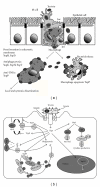Yersinia enterocolitica: Mode of Transmission, Molecular Insights of Virulence, and Pathogenesis of Infection
- PMID: 22567333
- PMCID: PMC3335483
- DOI: 10.4061/2011/429069
Yersinia enterocolitica: Mode of Transmission, Molecular Insights of Virulence, and Pathogenesis of Infection
Abstract
Although Yersinia enterocolitica is usually transmitted through contaminated food and untreated water, occasional transmission such as human-to-human, animal-to-human and blood transfusion associated transmission have also identified in human disease. Of the six Y. enterocolitica biotypes, the virulence of the pathogenic biotypes, namely, 1B and 2-5 is attributed to the presence of a highly conserved 70-kb virulence plasmid, termed pYV/pCD and certain chromosomal genes. Some biotype 1A strains, despite lacking virulence plasmid (pYV) and traditional chromosomal virulence genes, are isolated frequently from humans with gastrointestinal diseases similar to that produced by isolates belonging known pathogenic biotypes. Y. enterocolitica pathogenic biotypes have evolved two major properties: the ability to penetrate the intestinal wall, which is thought to be controlled by plasmid genes, and the production of heat-stable enterotoxin, which is controlled by chromosomal genes.
Figures




References
-
- Schleifstein JI, Coleman MB. Unidentified microorganisms resembling B. lignieri and Pasteurella pseudotuberculosis, pathogenic for man. New York State Journal of Medicine. 1939;39:1749–1753.
-
- Wauters G, Janssens M, Steigerwalt AG, Brenner DJ. Yersinia mollaretii sp. nov. and Yersinia bercovieri sp. nov., formerly called Yersinia enterocolitica biogroups 3A and 3B. International Journal of Systematic Bacteriology. 1988;38(4):424–429.
-
- O’ EV, Gall DG, Pai CH. Review article: Yersinia enterocolitica: mechanisms of microbial pathogenesis and pathophysiology of diarrhoea. Journal of Gastroenterology and Hepatology. 1990;5(2):173–179. - PubMed
LinkOut - more resources
Full Text Sources

